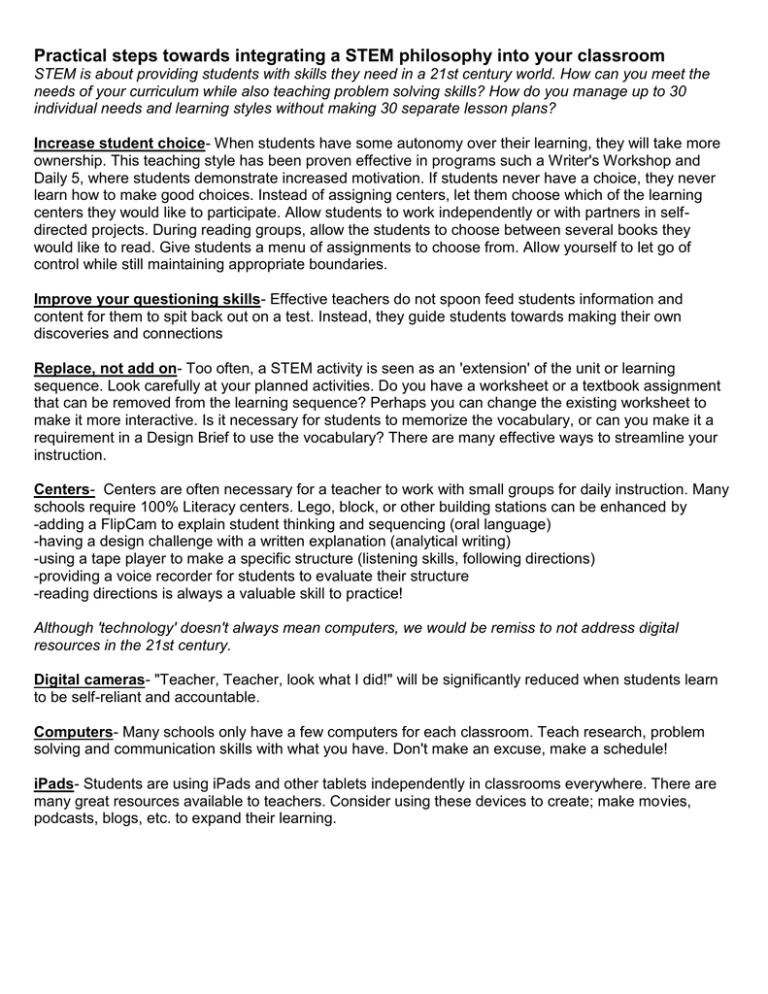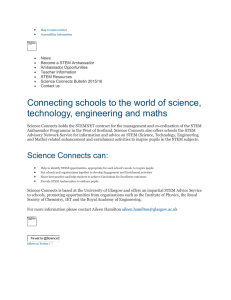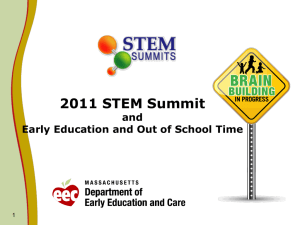Practical steps towards integrating a STEM philosophy into your classroom
advertisement

Practical steps towards integrating a STEM philosophy into your classroom STEM is about providing students with skills they need in a 21st century world. How can you meet the needs of your curriculum while also teaching problem solving skills? How do you manage up to 30 individual needs and learning styles without making 30 separate lesson plans? Increase student choice- When students have some autonomy over their learning, they will take more ownership. This teaching style has been proven effective in programs such a Writer's Workshop and Daily 5, where students demonstrate increased motivation. If students never have a choice, they never learn how to make good choices. Instead of assigning centers, let them choose which of the learning centers they would like to participate. Allow students to work independently or with partners in selfdirected projects. During reading groups, allow the students to choose between several books they would like to read. Give students a menu of assignments to choose from. Allow yourself to let go of control while still maintaining appropriate boundaries. Improve your questioning skills- Effective teachers do not spoon feed students information and content for them to spit back out on a test. Instead, they guide students towards making their own discoveries and connections Replace, not add on- Too often, a STEM activity is seen as an 'extension' of the unit or learning sequence. Look carefully at your planned activities. Do you have a worksheet or a textbook assignment that can be removed from the learning sequence? Perhaps you can change the existing worksheet to make it more interactive. Is it necessary for students to memorize the vocabulary, or can you make it a requirement in a Design Brief to use the vocabulary? There are many effective ways to streamline your instruction. Centers- Centers are often necessary for a teacher to work with small groups for daily instruction. Many schools require 100% Literacy centers. Lego, block, or other building stations can be enhanced by -adding a FlipCam to explain student thinking and sequencing (oral language) -having a design challenge with a written explanation (analytical writing) -using a tape player to make a specific structure (listening skills, following directions) -providing a voice recorder for students to evaluate their structure -reading directions is always a valuable skill to practice! Although 'technology' doesn't always mean computers, we would be remiss to not address digital resources in the 21st century. Digital cameras- "Teacher, Teacher, look what I did!" will be significantly reduced when students learn to be self-reliant and accountable. Computers- Many schools only have a few computers for each classroom. Teach research, problem solving and communication skills with what you have. Don't make an excuse, make a schedule! iPads- Students are using iPads and other tablets independently in classrooms everywhere. There are many great resources available to teachers. Consider using these devices to create; make movies, podcasts, blogs, etc. to expand their learning.




